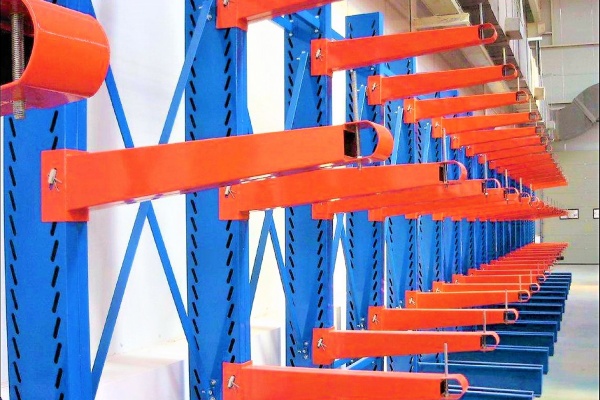Applications
The cantilever racking system is specifically designed for storing long, large, or irregularly shaped goods, suitable for the following scenarios:
- Pipe and Profile Storage: Widely used in industries such as steel and construction materials for storing pipes, profiles, and other long items like steel pipes, aluminum pipes, angle steels, and channel steels. The cantilever design allows for easy hanging and retrieval, preventing deformation and damage caused by stacking.
- Wood Storage: In the wood processing and storage sector, cantilever racks are used for storing logs, wooden boards, and other wood products. The position and number of cantilevers can be adjusted flexibly according to the size and quantity of the wood, achieving efficient storage and management.
- Mechanical Parts Storage: For irregularly shaped, large mechanical parts such as crankshafts, drive shafts, molds, etc., cantilever racks provide appropriate support and storage space, facilitating the classification and easy retrieval of parts.
- Irregular Shaped Goods: Such as furniture, decorative materials, etc.
Core Functions
- Flexible Storage: Cantilevers can be freely adjusted in length, angle, and spacing to accommodate various sizes and shapes of goods, enhancing the versatility and flexibility of the rack.
- Easy Access: Goods can be directly hung or placed on the cantilever, allowing for retrieval without moving other items. Workers can load and unload from the side of the rack, which significantly improves the efficiency of stock entry and exit.
- Space Utilization: Cantilever racks typically feature an open structure that occupies minimal horizontal space, making full use of the warehouse’s vertical space for three-dimensional storage, thus improving space utilization.
- High Load Capacity: The structural design is robust, with individual cantilevers capable of supporting several tons, making it suitable for storing large and heavy items.
- Categorized Management: Goods can be stored and categorized according to type and specifications, with each cantilever serving as an independent storage unit. This enhances the accuracy and convenience of inventory management and labeling.
Key Advantages
- Designed for Long Goods: The cantilever structure is particularly suited for storing long and large items, meeting special storage requirements.
- High Load Capacity: The main rack and cantilevers are rigorously designed and processed to ensure stability and strength, capable of handling heavy loads without deformation, ensuring the safe storage of goods.
- Adjustable Flexibility: Cantilever length and height are adjustable to accommodate different sizes of goods. As business grows or storage needs increase, the cantilever system can be easily expanded or upgraded by adding additional levels, cantilevers, or extending the rack length to meet evolving storage requirements.
- Space-Saving: The open design maximizes warehouse space utilization.
Specifications
- Rack Height: Typically 2-6 meters, customizable based on warehouse height. Lower racks are suitable for easy manual access, ideal for small warehouses or areas with high frequency of goods movement. Higher racks are suitable for large warehouses, making use of vertical space, but may require forklifts or other mechanical equipment for operation.
- Cantilever Length: Typically 0.5-1.5 meters, customizable based on the length of the goods.
Load Capacity: The load capacity of a single arm is typically 50-100 kg, adjusted according to actual use requirements. - Layer Spacing: Generally between 0.5 – 1.5 meters, adjustable according to the height of the goods.
- Structure Design: Single-sided or double-sided design, chosen based on the warehouse layout.
- Installation Method: Can be fixed to the ground to ensure stability.


